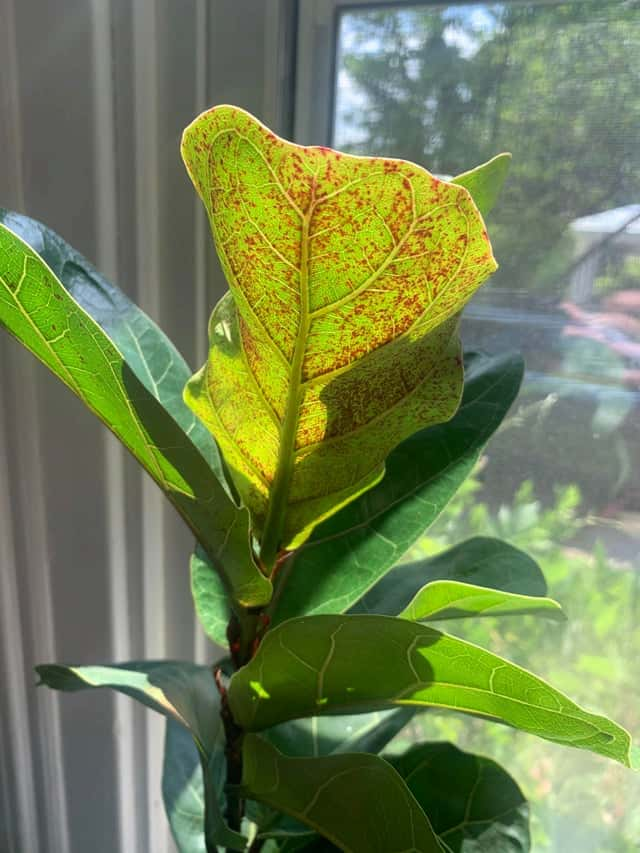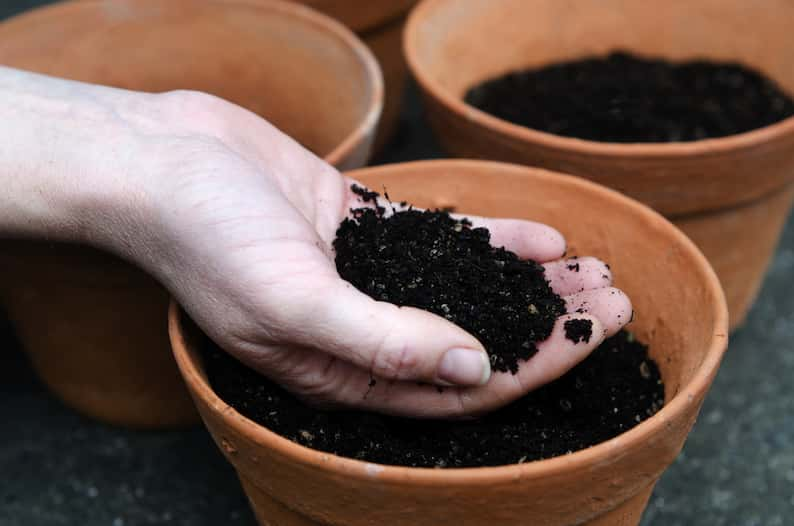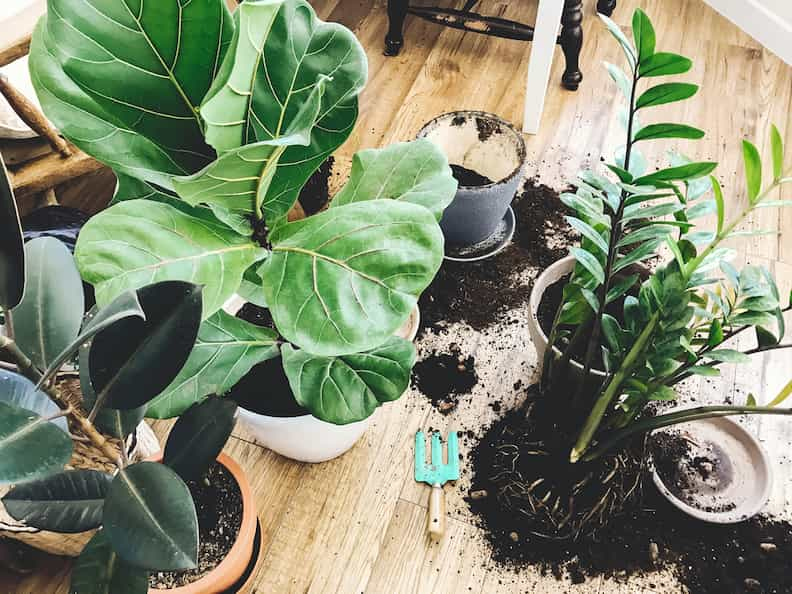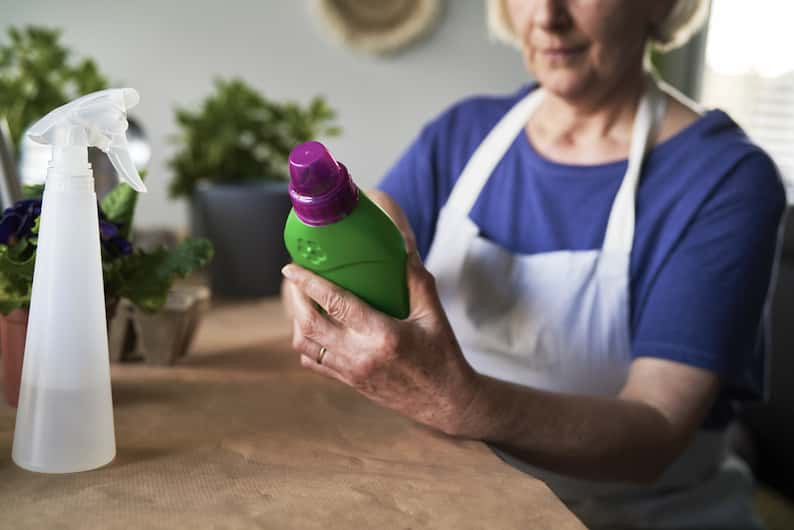It’s pretty likely that one of the reasons you bought your fiddle leaf fig was due to its large, showy green leaves. This means that when something happens that affects their beautiful shiny green glory, like if your fiddle leaf fig develops red spots on its leaves, it’s really not the preferred outcome for most houseplant lovers.
Fortunately, while there are a few reasons why your fiddle leaf fig has red spots, most of them are entirely fixable. By working your way through the various potential problems, you’ll soon be able to figure out the solution to this problem – and, ideally, how to prevent your fiddle leaf fig having red spots in future.
So keep reading to find out the most common causes of red spots on the leaves of fiddle leaf figs and the steps you should take to get this under control.

Table of Contents
Why does my fiddle fig have red spots?
There are several reasons for red spots on the leaves of your fiddle leaf fig plant.
1. Edema or moisture stress
Edema, also known as oedema, occurs when your fiddle leaf fig plant’s roots take up water faster than the plant can use it for transpiration. This causes water pressure to build up inside the leaf’s cells and burst the cells. The dead cells then appear as red spots on the leaves.
Edema or moisture stress can be caused by overwatering your fiddle leaf fig. Still, other environmental factors, such as too much humidity or lack of proper air circulation around your plant, also contribute to edema.
2. Spider mites
Insects can also cause plant cells to burst and leave behind the telltale sign of tiny red spots on the leaves of your fiddle leaf fig (although white spots on your fiddle leaf fig can also be a sign of these little critters). The most common are spider mites and false spider mites, both of which are tiny insects that are best seen with a magnifying glass.
Spider mites on a fiddle leaf fig leave behind thin wispy webs on the leaves of your plants. The webs are easier to see than the spider mites themselves. If you discover tiny webs on your fiddle leaf fig, spider mites are likely the source.
Spider mites range in color from green or translucent to white or orangish-red. Examine the undersides of your fiddle leaf fig leaves to determine if spider mites are the cause of the red spots on your leaves.
3. False spider mites
False spider mites do not leave webs on the plant. They often elude detection because they feed on the undersides of the leaves.
These tiny mites are orange or red with black spots. Their flattened body is usually held close to the leaf or stem, where they may be mistaken for dust or other debris.
4. Bacterial Infections
A fiddle leaf fig with a bacterial infection isn’t as common an issue as with other plants, but this can sometimes be the source of brown and red spots forming on the leaves of your plants. A bacterial infection generally affects all the leaves on the plant.
The first signs of a bacterial infection are often spots along the margins of the leaves. They may also appear along the veins.

5. Fungal infections
Like bacterial infections, fungal infections can sometimes present as red spots on the leaves of your fiddle leaf fig plant. The most common fungal infection affecting fiddle leaf fig plants is root rot that results from overwatering or soggy soil.
Root rot attacks the plant’s roots, compromising their ability to regulate and uptake water and nutrients. While root rot commonly causes large brown spots in your fiddle leaf fig’s foliage, it can sometimes cause red spots on the leaves.
6. Sunburn
A sunburned fiddle leaf fig can lead to your plant having damaged leaves if it’s exposed to too much sun. This typically happens if you move your plant to more sun than it is accustomed to.
While damage from too much sun generally appears as white patches called sunscald, it can sometimes cause tiny red or brown spots on the leaves.
7. Underwatered fiddle leaf fig
An underwatered fiddle leaf fig can also develop red spots. While these mostly present as being more brown than red, they do have a red tinge which is due to your plant’s roots not having sufficient water to absorb the minerals contained in the soil.
How do you fix red spots on a fiddle leaf fig?
Once you have identified the cause of the red spots on your fiddle leaf fig, you will need to take steps to correct the underlying cause. Here’s how:
1. Let your plant’s soil dry out
As explained earlier, edema is the most common cause of red spots on the leaves of your fiddle leaf fig plants. This happens when the plant’s roots absorb more moisture than the leaves can process through transpiration. The moisture engorged cells burst and leave behind tiny red spots on the leaves.
To correct red spots from edema, make sure to let the top 2 to 3 inches of the soil dry out before watering your fiddle leaf fig again.

2. Check humidity levels
Similarly, edema can also be caused by too much humidity or lack of air circulation.
For that reason, you should also check that the environment is not too humid and take steps to lower the humidity. Likewise, make sure your plants are not overcrowded, so air can circulate freely around the plant.
3. Remove any pest infestations
Spider mites and false spider mites can leave behind tiny red spots from piercing and sucking the juices from the leaves on your fiddle leaf fig. To correct red spots from insect damage, you will need to take steps to rid your plant of the pests.
Washing the leaves with warm soapy water is often effective in removing spider mites and false spider mites if you have a minor infestation. You can also move your plant to the sink or shower and use the sprayer to wash the insects away.
For a more severe infestation, use insecticidal soap or neem oil to kill the insect pests.
4. Resolve any bacterial infections
If bacterial infections are the cause of red spots on your fiddle leaf fig’s foliage, you will need to take action right away before it spreads to the rest of the tree.
Remove any affected leaves and discard them in the trash away from other plants.

Repot your fiddle leaf fig plant in fresh soil in a new plant pot. If you choose to reuse your existing plant pot, it is essential to sterilize it first.
Mix one part household bleach with nine parts water and submerge your fiddle leaf fig’s planter in the solution. Allow it to soak for 15 to 20 minutes, and then scrub it clean with a stiff brush. Allow it to air dry before using it to repot your fiddle leaf fig plant.
5. Address any fungal infections
Fungal infections causing red spots on your fiddle leaf fig’s leaves typically progress to root rot. Root rot in a fiddle leaf fig can kill your plant if it is not treated promptly.
Remove the plant from the pot and examine the roots. Healthy roots are white or tan and pliable. Roots with root rot are brown or black and mushy.
Rinse the soil from the roots so you can get a good look. Trim away any discolored or diseased roots. Repot the plant in fresh soil and a new (or sterilized) plant pot.
6. Correct sun damage
Red spots on your fiddle leaf fig from sun damage are easy to correct.
Remove the damaged leaves and move the plant to a location with less light. In terms of fiddle leaf figs’ light needs, they prefer 6 hours of direct sunlight a day, but young or new plants from the nursery may need to acclimate to full sun gradually.
7. Double check your watering schedule
While it’s much more likely to have red spots on a fiddle leaf fig from overwatering, as mentioned above, underwatering can also lead to this.
Either way, keeping an eye on your watering schedule can help solve either problem. This may involve slightly adjusting your existing schedule if, say, the seasons have changed and so the temperature increase means you have to water more frequently. The so-called finger test can help you figure out how often to water your fiddle leaf fig.
Related: Fiddle Leaf Fig Temperature Needs: What’s Ideal?
How do you prevent a fiddle leaf fig from having red spots?
The best way to prevent fiddle leaf figs from getting red spots is to provide them with the growing conditions they prefer. Here’s a brief review of what they need to thrive.
- Watering when the soil is dry 2 to 3 inches below the surface. Watering too frequently is a common cause of edema.
- Well-drained soil. Water should run freely through the soil when you water your fiddle leaf fig. Soggy soil can lead to both edema and root rot. Take a look at the best soil for fiddle leaf figs to see the exact type that works for this plant.
- Humidity between 30 and 65 percent. If the humidity level is too high, your fiddle leaf fig may suffer edema and develop red spots. Drops of moisture on the tips of leaves are a sign the humidity is too high.
- Plenty of air circulation. Grouping plants too closely can cause air circulation issues and lead to edema in fiddle leaf figs.
- Monitoring for insect pests. Check your plants frequently for any signs of insect pests. Remember, the telltale sign of spider mites is tiny webs on your plants.
- Adequate sunlight. Fiddle leaf figs like to get six hours of direct sunlight a day. Having too much or too little sunlight can result in your fiddle leaf fig developing red spots.
What are the red dots on leaves?
The red dots or spots on the leaves of your fiddle leaf fig tree are the visual evidence that plant cells have died. The most common reason is edema. Edema occurs when the plant’s roots take up more water than the plant can handle.
Because the cells in the leaves are engorged with water and cannot get rid of it fast enough through transpiration, the cells burst and leave behind tiny red spots.
Will edema go away on a fiddle leaf fig?
Edema in plants is common, but it is not a permanent condition. Correcting your watering routine, lowering the humidity, and improving air circulation generally take care of the problem and new red spots will not appear.
However, the existing red spots caused by edema will not disappear, but they often fade as the leaves mature and are not as noticeable.
Severely damaged leaves with unsightly red spots can be pruned from your fiddle leaf fig.
How do you treat fiddle leaf fig edema?
If your fiddle leaf fig plant is suffering from edema, you need to take measures to restore the water balance in the plant. In most cases, improving your watering routine (and checking that you have well-draining soil) will correct the problem.
If high humidity and poor air circulation are also an issue, lowering the humidity level around your plants and making sure there is ample room for air to circulate freely around the plant may be needed.
Should you remove leaves with red spots?
Whether you remove the leaves with red spots depends on the severity of the problem and the underlying cause. Leaves with few red spots from edema or as the result of insect pests do not need to be removed from the plant and do not compromise the plant’s health.
However, leaves with red spots from bacterial or fungal diseases should be removed from the plant to prevent the disease from spreading to other areas of the plant. Likewise, bacterial and fungal infections can spread to your other houseplants if they are left untreated, and the infected foliage is not removed.

Leaves with red spots from sunburn can be removed from the plant if large leaf areas are affected or otherwise unsightly. A few spots along the edge of the leaf or sprinkled across the center do not threaten the plant and can be left alone.
Fiddle leaf figs are susceptible to moisture stress and edema and often have a few fiddle leaf fig red spots on the leaves. Unless the condition is severe or spreads to other leaves, they should not cause concern. Your fiddle leaf fig tree will thrive inside your home with proper care and good watering habits.
Final thoughts on your fiddle leaf fig’s red spots
While it’s not ideal if your fiddle leaf fig has red spots, it’s also not the end of the world. Like many fiddle leaf fig problems, you can almost certainly fix any red spots on your fiddle leaf fig by making some slight adjustments to your plant maintenance schedule.
For example, a fiddle leaf fig with edema sounds much scarier than it actually is. Instead, by changing your watering habits, the new leaves forming on your Ficus will almost certainly be as good as new. Similarly, while getting rid of a pest or fungal infection sounds tricky, it’s really not that hard to do and before you know it, your fiddle leaf fig tree’s red spots will be a distant memory.
